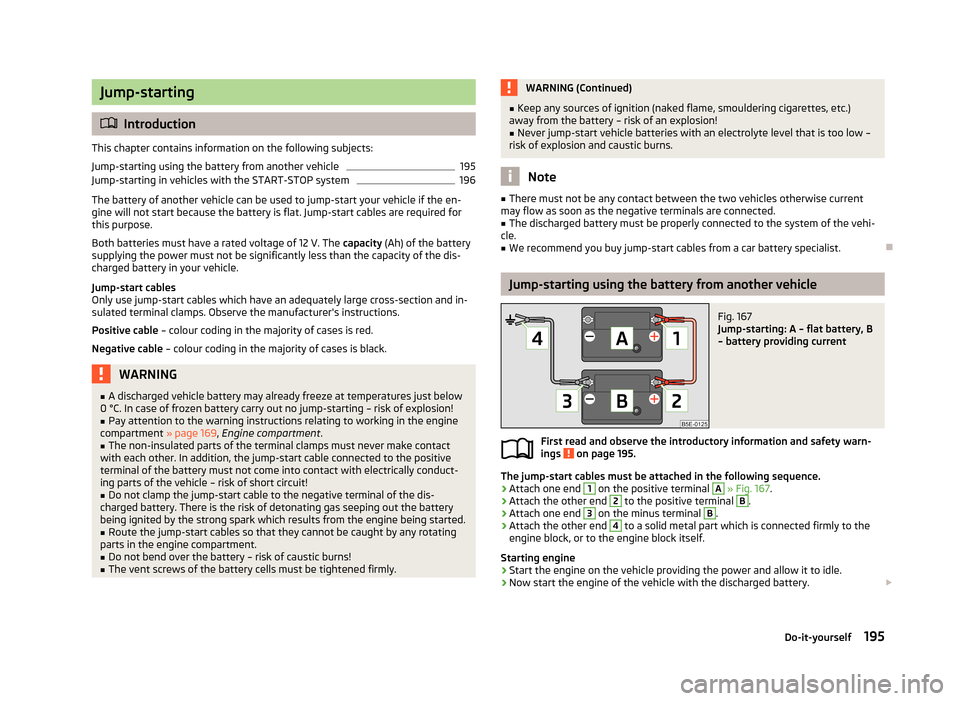jump start terminals SKODA OCTAVIA 2012 2.G / (1Z) Owner's Manual
[x] Cancel search | Manufacturer: SKODA, Model Year: 2012, Model line: OCTAVIA, Model: SKODA OCTAVIA 2012 2.G / (1Z)Pages: 222, PDF Size: 13.52 MB
Page 197 of 222

Jump-starting
Introduction
This chapter contains information on the following subjects:
Jump-starting using the battery from another vehicle
195
Jump-starting in vehicles with the START-STOP system
196
The battery of another vehicle can be used to jump-start your vehicle if the en-
gine will not start because the battery is flat. Jump-start cables are required for
this purpose.
Both batteries must have a rated voltage of 12 V. The capacity (Ah) of the battery
supplying the power must not be significantly less than the capacity of the dis- charged battery in your vehicle.
Jump-start cables
Only use jump-start cables which have an adequately large cross-section and in-
sulated terminal clamps. Observe the manufacturer's instructions.
Positive cable – colour coding in the majority of cases is red.
Negative cable – colour coding in the majority of cases is black.
WARNING■
A discharged vehicle battery may already freeze at temperatures just below
0 °C. In case of frozen battery carry out no jump-starting – risk of explosion!■
Pay attention to the warning instructions relating to working in the engine
compartment » page 169, Engine compartment .
■
The non-insulated parts of the terminal clamps must never make contact
with each other. In addition, the jump-start cable connected to the positive
terminal of the battery must not come into contact with electrically conduct-
ing parts of the vehicle – risk of short circuit!
■
Do not clamp the jump-start cable to the negative terminal of the dis-
charged battery. There is the risk of detonating gas seeping out the battery
being ignited by the strong spark which results from the engine being started.
■
Route the jump-start cables so that they cannot be caught by any rotating
parts in the engine compartment.
■
Do not bend over the battery – risk of caustic burns!
■
The vent screws of the battery cells must be tightened firmly.
WARNING (Continued)■ Keep any sources of ignition (naked flame, smouldering cigarettes, etc.)
away from the battery – risk of an explosion!■
Never jump-start vehicle batteries with an electrolyte level that is too low –
risk of explosion and caustic burns.
Note
■ There must not be any contact between the two vehicles otherwise current
may flow as soon as the negative terminals are connected.■
The discharged battery must be properly connected to the system of the vehi-
cle.
■
We recommend you buy jump-start cables from a car battery specialist.
Jump-starting using the battery from another vehicle
Fig. 167
Jump-starting: A – flat battery, B
– battery providing current
First read and observe the introductory information and safety warn-
ings on page 195.
The jump-start cables must be attached in the following sequence.
›
Attach one end
1
on the positive terminal
A
» Fig. 167 .
›
Attach the other end
2
to the positive terminal
B
.
›
Attach one end
3
on the minus terminal
B
.
›
Attach the other end
4
to a solid metal part which is connected firmly to the
engine block, or to the engine block itself.
Starting engine
›
Start the engine on the vehicle providing the power and allow it to idle.
›
Now start the engine of the vehicle with the discharged battery.
195Do-it-yourself